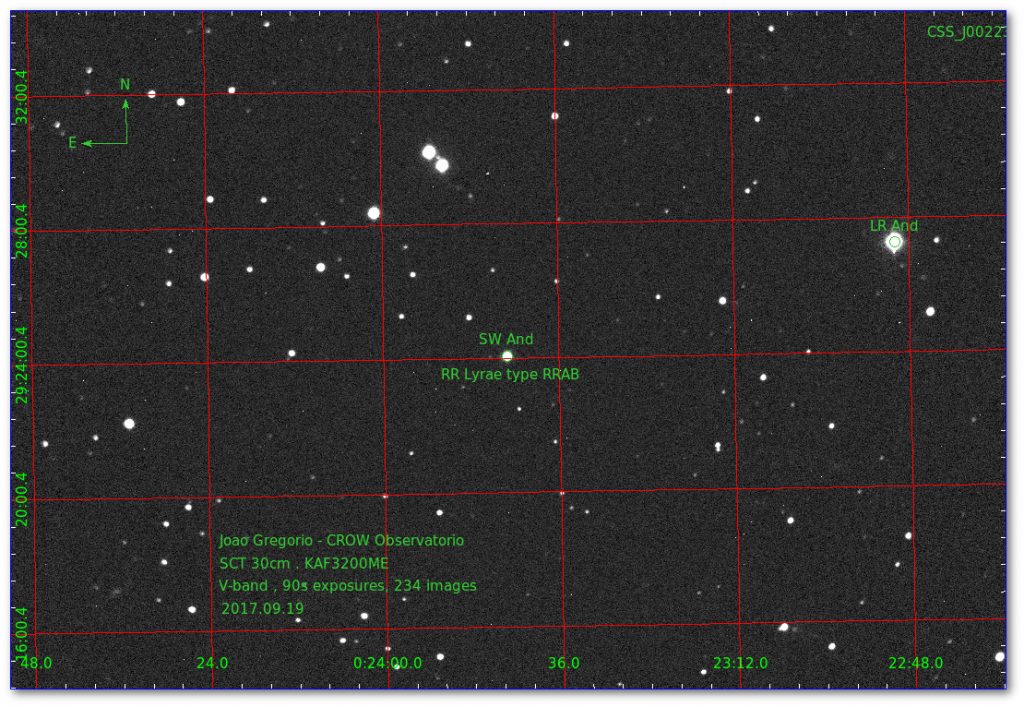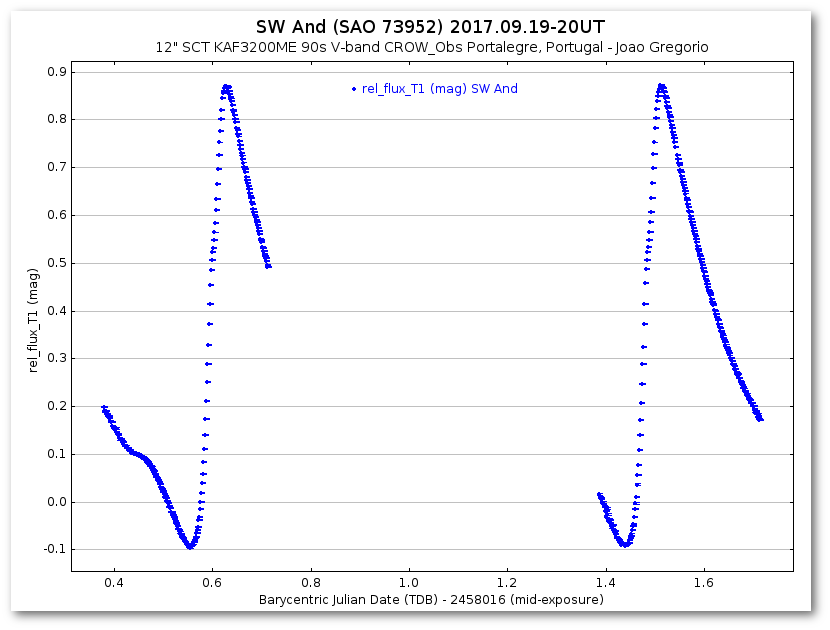Inspired by a recent work by Cedric Pereira, I decided to give a try on a long forgotten wish list from 2eme Ecole d'astrophysique du CNRS-Centre National de la Recherche Scientifique La Rochelle in 2006 Pro-Am meeting, where I assisted a talk from Le Borgne on RRLyrae and the Blazhko effect.
After some evaluation of a good positioned constellation to observe all night I chose Andromeda. The next step was to find a nice RR Lyrae type star and the winner was SW And, a ~V10 A7IIImF0
From SIMBAD we get this information.
| V* SW And — Variable Star of RR Lyr type | |||||||
| Other object types: | * (AG,BD,...), V* (V*,AN), RR* (Ref), IR (2MASS) | ||||||
| ICRS coord. (ep=J2000) : | 00 23 43.0896 +29 24 03.626 (Optical) [ 0.310 0.175 0 ] A 2016A&A...595A...2G | ||||||
| FK5 coord. (ep=J2000 eq=2000) : | 00 23 43.090 +29 24 03.63 [ 0.310 0.175 0 ] | ||||||
| FK4 coord. (ep=B1950 eq=1950) : | 00 21 05.70 +29 07 27.2 [ 66.501 44.001 0 ] | ||||||
| Gal coord. (ep=J2000) : | 115.7250 -33.0825 [ 0.310 0.175 0 ] | ||||||
| Proper motions mas/yr : | -6.86 -17.58 [1.33 0.88 0] A 2007A&A...474..653V | ||||||
| Radial velocity / Redshift / cz : |
V(km/s) -20.80 [1.7] / z(~) -0.000069 [0.000006] / cz -20.80 [1.70] B 2006AstL...32..759G |
||||||
| Parallaxes (mas): | 1.77 [0.26] A 2016A&A...595A...2G | ||||||
| Spectral type: | A7IIImF0 C 1957ApJ...126..291B | ||||||
| Fluxes (6) : |
|
||||||
Here is a plot of the star observability.
After a period of cooling down the telescope and the CCD, checking the pointing and focusing I started the long night session hopping the weather would collaborate.
From Hipparcos I got this suggestive plot to see if I could do something at least similar.
For the observation I used a photometric V-band filter and 90s exposures in a total of 234 images. The night was nice and stable.
A meridian flip was performed in this 8 hour long marathon. The plot can be appreciated below showing an amplitude of almost 1 magnitude. The period is 0.4422618d (~10h37) so the observation came a bit short. I'll try to observe tomorrow is the weather olds and see if I can get the full period.
This star is in the list of stars showing the Blazhko effect. It varies its amplitude in a 36.8 day time scale. Bellow we can see an example animation of that effect in a star with 85.9d secondary period.
click on the image below.
(c) Illustration of the lightcurve changes over the Blazhko cycle (created by D. Welch based on MACHO project data, Alcock et al. 2000).
It was a fun observation and requires more data to complete de period and a lot more to see the 36.8d Blazhko effect.
…. Well, the weather was good on the following night and I made another 8h observation trying to catch the rest of the missing period.
The night wasn't as good has the previous one with clouds at the beginning of the session.
Joining the two datasets we get this plot and by the looks I think I have the full phase of the event.
Here is the phase plot… I find a period of 0.442211 days
The end.
If you are a pro and want to use the data please contact me joao "." gregas "@" gmail "." com
Joao Gregorio








